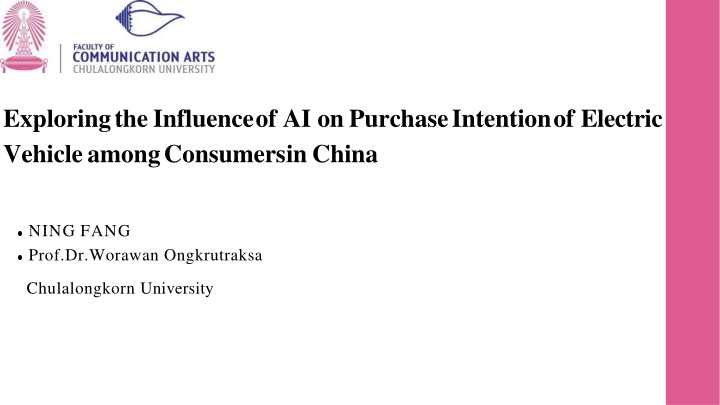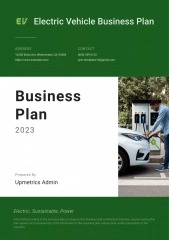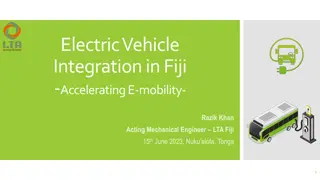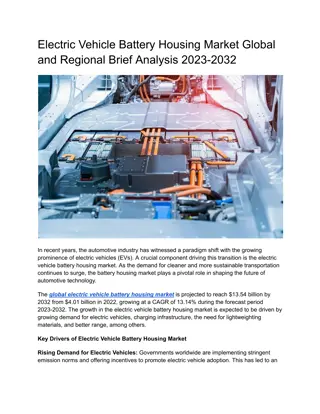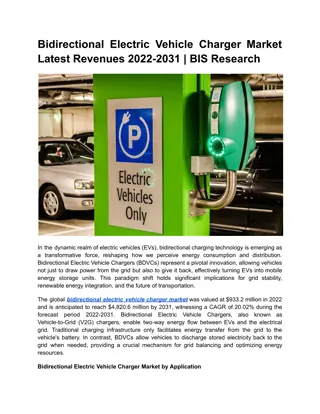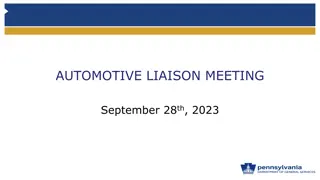Impact of AI on Electric Vehicle Purchase Intention in China
Exploring the influence of artificial intelligence (AI) on the purchase intention of electric vehicles (EVs) among consumers in China. The study delves into factors such as perceived usefulness, ease of use, enjoyment, cyber risks of AI, and their effects on EV purchase intent. It also highlights the role of AI in enhancing consumer communication and addresses the challenges hindering EV sales in Chinese inland cities due to slow technology diffusion.
Download Presentation

Please find below an Image/Link to download the presentation.
The content on the website is provided AS IS for your information and personal use only. It may not be sold, licensed, or shared on other websites without obtaining consent from the author.If you encounter any issues during the download, it is possible that the publisher has removed the file from their server.
You are allowed to download the files provided on this website for personal or commercial use, subject to the condition that they are used lawfully. All files are the property of their respective owners.
The content on the website is provided AS IS for your information and personal use only. It may not be sold, licensed, or shared on other websites without obtaining consent from the author.
E N D
Presentation Transcript
Exploring the Influence of AI on Purchase Intention of Electric Vehicle among Consumers in China NING FANG Prof.Dr.Worawan Ongkrutraksa Chulalongkorn University
Introduction 1 Literature Review 2 3 Methodology Agenda Data Analysis and Discussion 4 Conclusion 5
Introduction Part 1
Background 1 China's manufacturing activity has surged at the fastest rate in over a decade. The urbanization rate reached 64.72 percent in 2021 and increased by 1.1 percentage points in 2022. Serious environmental challenges; China: The world's largest emitter of CO2. The number of cars ranked second worldwide. Public environmental protection increased (90% of consumers are aware of sustainable consumption, 70% of consumers are very conscientious of it) Growing public concerns about environmental issues have not led to a parallel increase in the consumption of green products (the consumption of eco-friendly products in China remains low at 20%. )
The public awareness, willingness to buy and technology diffusion is main reasons slow the EV sales down, especially in the Chinese inland cities (Liu et al., 2023). Green marketing communication is key AI one of the most significant tool to help the company gather data on product lifecycles, enable remote monitoring, and enhance opportunities for maintenance services, product reuse, and remanufacturing (Ghoreishi & Happonen, 2020). Chatbots are widely use in daily life. ChatGPT, Siri, Ernie Bot
Perceived usefulness (PU) Perceived ease of use (PEU) Perceived enjoyment (PE) Perceived cyber risks (PCR) Research Objective 1. To study PU, PEU and PE, PCR of AI, and purchase intention of EV among consumers in China. 2. To study the effects of PU, PEU and PE, PCR of AI on the purchase intention of EV among consumers in China. Research Question 1. What are the PU, PEU, PE, PCR of AI, and purchase intention of EV among consumers in China? 2. What are the effects of PU, PEU and PE, PCR of AI on the purchase intention of EV among consumers in China?
Excepted Benefits 2 Practically Academically AI can be a valuable ally to humans, not a replacement. It empowers marketers to enhance consumer communication effectively.
Literature Review Part 2
Artificial Intelligence 1 Chat-based or conversational bots aim to respond appropriately to user input, continuing a conversation with techniques like cross-questioning. Powered by AI and equipped with natural language understanding (NLU) capabilities. Leveraging AI, they swiftly detect relevant contextual information from user input, utilizing databases and pattern matching to deliver accurate responses. Example: Siri, ChatGPT, Ernie Bot (Nimavat & Champaneria, 2017). In summary AI is a double-edged sword. To address these challenges, maximize AI's benefits to assist people is key. This paper seeks to expand on this foundation by exploring how AI, specifically chatbots, can help human life rather than replace them.
2 Green marketing Strategy & Communication Green marketing strategy is all marketing activities that have served to help environmental issues and that may serve to provide a remedy for environmental problems (Pasto et al., 1976).The goal of green communication is to transmit detailed information to consumers about the company's green products, commitments, efforts, and results in the field of environmental protection and quality of life (Danciu, 2006; Mera, 2003). In summary, green marketing strategy vital but complex; Green products information too precise or too abstract (Nittala, 2014). AI-driven chatbots can bridge the gap, providing clear, understandable information to consumers. This paper delves into the importance of green marketing, AI's role in green communication, and the growing significance of sustainability in consumer and business decisions.
Technology Acceptance Model 3 Perceived of usefulness H1 H2 Perceived ease of use Purchase Intention H3 Perceived enjoyment H4 Perceived cyber risks
Hypothesis H1: Perceived usefulness (PU) of AI affects consumers purchase intention towards EV. H2: Perceived ease of use (PEU) of AI affects consumers purchase intention towards EV. H3: Perceived enjoyment (PE) of AI affects consumers purchase intention towards EV. H4: Perceived cyber risks (PCR) of AI affects consumers purchase intention towards EV.
Purchase Intention 4 Purchase intention refers to a person's propensity to purchase a certain good, and it is a crucial factor in assessing consumer behavior (Fishbein & Ajzen, 1977). Key in the success of a company's marketing. TAM offers a valuable framework. By leveraging TAM, marketers can enhance their marketing strategies to boost purchase intention among consumers, particularly in the context of environmentally conscious purchasing decisions. Electric Vehicle 5 The adoption of EV is crucial in mitigating air pollution and reducing carbon emissions, especially in China. As the world s biggest national market for EV, the market share accounts for 44%, however have a slight decline recent years.
Methodology Part 3
Quantitative methodology Online questionnaire Purposive sampling Pre-Testing 5-point Likert scale SPSS Multiple Regression analysis
Age between 31-40 High income, high education living in Shanghai city 300 Respondents Main buyer Have intention to use AI and EV,or have experience using AI and EV
Data analysis and Discussion Part 4
Reliability Analysis The overall reliability coefficient value of the scale is =0.889, indicating good internal consistency and stability of this questionnaire in general. At the same time, the coefficient of reliability value of each subscale is greater than 0.7, indicating that each subscale had good stability.
Validity Analysis The KOM value is 0.758, and the Bartlett's sphericity test showed P=0.000. This indicates that the overall validity of the questionnaire is good. The Cronbach s alpha value for PU, PEU, PE, PCR scales are all over 0.7, ensuring high reliability of the scale. Moreover, these values are in concurrence with the original scale which all had reliability over 0.7 (Holdack et al., 2022; Liu, 2022; Vafaei-Zadeh et al., 2022; Woo & Kim, 2019).
Conclusion Part 5
In conclusion, the positive outcomes from the pre-testing phase of the thesis are encouraging and signify the effectiveness of the research design and data collection instruments. The favorable results indicate that the chosen methods for testing the thesis components, whether they are survey instruments, experimental procedures, or any other elements, have been successful in achieving their intended goals. This success in the pre-testing phase is a positive sign that the research is on the right track.
